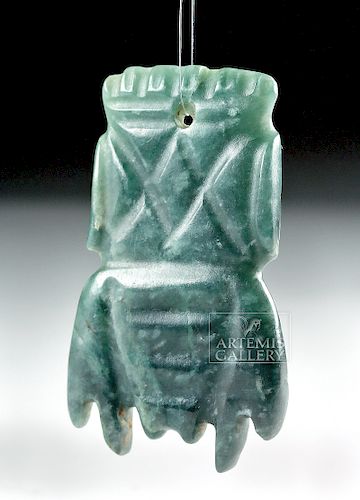Costa Rican Jade Pendant of an Insect, ex-Woram
Lot 146d
About Seller
Artemis Gallery
686 S Taylor Ave, Ste 106
Louisville, CO 80027
United States
Selling antiquities, ancient and ethnographic art online since 1993, Artemis Gallery specializes in Classical Antiquities (Egyptian, Greek, Roman, Near Eastern), Asian, Pre-Columbian, African / Tribal / Oceanographic art. Our extensive inventory includes pottery, stone, metal, wood, glass and textil...Read more
Estimate:
$2,500 - $3,500
Absentee vs Live bid
Two ways to bid:
- Leave a max absentee bid and the platform will bid on your behalf up to your maximum bid during the live auction.
- Bid live during the auction and your bids will be submitted real-time to the auctioneer.
Bid Increments
| Price | Bid Increment |
|---|---|
| $0 | $25 |
| $300 | $50 |
| $1,000 | $100 |
| $2,000 | $250 |
| $5,000 | $500 |
| $10,000 | $1,000 |
| $20,000 | $2,500 |
| $50,000 | $5,000 |
| $100,000 | $10,000 |
| $200,000 | $20,000 |
About Auction
By Artemis Gallery
Feb 21, 2019
Set Reminder
2019-02-21 10:00:00
2019-02-21 10:00:00
America/New_York
Bidsquare
Bidsquare : Exceptional Antiquities, Asian, Ethnographic
https://www.bidsquare.com/auctions/artemis-gallery/exceptional-antiquities-asian-ethnographic-3858
An important one-day auction featuring museum-worthy examples of Egyptian, Greek, Roman, Etruscan, Near Eastern, Far East / Asian, Pre-Columbian, African / Tribal, Oceanic, Native American, Spanish Colonial, Russian, Fossils, Ancient Jewelry, Fine Art, so much more! Artemis Gallery info@artemisgallery.com
An important one-day auction featuring museum-worthy examples of Egyptian, Greek, Roman, Etruscan, Near Eastern, Far East / Asian, Pre-Columbian, African / Tribal, Oceanic, Native American, Spanish Colonial, Russian, Fossils, Ancient Jewelry, Fine Art, so much more! Artemis Gallery info@artemisgallery.com
- Lot Description
Pre-Columbian, Costa Rica, ca. 200 to 600 CE. An intriguing Costa Rican jade pendant comprised of gorgeous blue-green jadeite that was carved and string cut to depict a winged insect - the jade elegantly translucent in areas when held to the light - with a perforation at the top for suspension. The artistry and detail on this piece is mesmerizing. Notice the wings protruding at the sides of the bug's body, the horizontal striations across the thorax, the intersecting zigzag motifs on the head - perhaps to indicate the creature's compound eyes, as well as the fretted upper terminal perhaps to signify the bug's mandible. Given that Costa Rica is known for its remarkable variety of insects today, perhaps the ecology of ancient Costa Rica also presented a plethora of our buzzing friends. Size: 2.375" H (6 cm)
Costa Rica, along with Mesoamerica, is one of the two regions where jade was extensively carved in the Pre-Columbian world. The earliest example of worked jade, a pendant excavated from a burial site on the Nicoya Peninsula, dated to the mid-first millennium BCE. It appears that jade continued to be carved into personal ornaments, usually depicting animals such as birds, monkey, frogs, or insects like this example, until approximately 700 CE when gold became the favored material to fashion such ornaments.
Provenance: ex-private West Palm Beach, Florida, USA collection; ex-Woram collection, acquired in the 1950s to 1960s - major collectors of Pre-Columbian jade artifacts from Christie's, Sotheby's, and all the major auction houses
All items legal to buy/sell under U.S. Statute covering cultural patrimony Code 2600, CHAPTER 14, and are guaranteed to be as described or your money back.
A Certificate of Authenticity will accompany all winning bids.
We ship worldwide and handle all shipping in-house for your convenience.
#143694Remains of old inventory label on verso. Perforated at the upper end for suspension. Intact and excellent!Condition
- Shipping Info
-
All shipping is handled in-house for your convenience. Your invoice from Artemis Gallery will include shipping calculation instructions. If in doubt, please inquire BEFORE bidding for estimated shipping costs for individual items.
-
- Buyer's Premium



 EUR
EUR CAD
CAD AUD
AUD GBP
GBP MXN
MXN HKD
HKD CNY
CNY MYR
MYR SEK
SEK SGD
SGD CHF
CHF THB
THB













